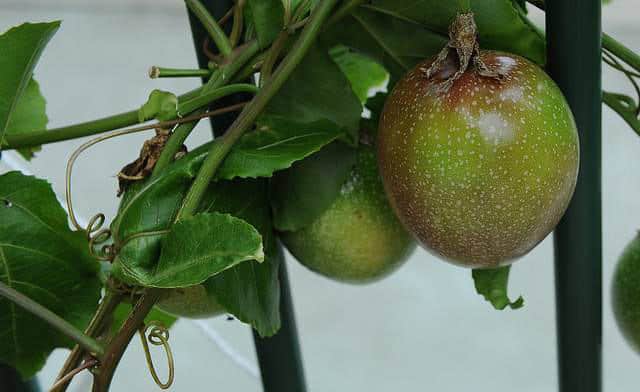Passion fruit can be found in the wild and is also commercially cultivated in warm and mostly frost-free climates throughout the tropical and sub-tropical world. The fruit is native to Brazil, Paraguay, Uruguay, and northern Argentina. The purple variety even grows well in colder climates as far north as China and Northern California, where it has been known to survive freezing temperatures. The yellow variety requires much warmer climates. On average, commercial plantation yields range from 9,000 kg. to 16,000 kg. per acre.
The passion fruit has a pleasing tart, slightly acid, and astringent flavor which becomes sweeter as it ripens. Its flavor has been described as being similar to that of guava. It has a juicy and custardy interior filled with an aromatic orange-colored juice and tiny crunchy seeds. This filling can be eaten as is or strained to remove the seeds. Its flavor pairs well with citrus and at home, the juice is often added to other juices to improve their flavor. For large-scale processing, the juice is sweetened or diluted with other juices or even milk to make tasty juice blends.
The fruit is consumed in a variety of ways throughout the world. The juice can be boiled down and reduced to make syrup which can then be added to mousses, ice cream, and cheesecake. In some countries, the pulp is added to salads, yogurt, pastries, ceviche, alcoholic drinks, cooked down as preserves, used as a soft drink flavoring, or consumed straight from the fruit. In the Philippines, vendors sell the fruit with a straw to make it easier to consume the juicy filling.
Passion fruit can also be used in other ways. Pectin can be extracted from the rind, or the rind can be chopped, dried, and combined with other ingredients to be used as livestock feed. The seeds can yield an oil which has edible and industrial uses. According to Purdue University’s “Fruits of Warm Climates” database, passion fruit seed oil is similar to sunflower and soybean oils.
According to the U.S. Department of Agriculture (USDA), passion fruit is a very good source dietary fiber, niacin, iron, vitamin A, and vitamin C as well as good source of potassium and riboflavin. There has been a recent upsurge in interest in the medicinal properties of passion fruit from the pharmaceutical industry. A study carried out by the Arizona College of Public Health found that passion fruit rind administered in medicinal form may alleviate asthma symptoms due to its anti-oxidant, anti-allergenic, and anti-inflammatory properties. Passion fruit is also high in lycopene, a type of antioxidant; many studies, including one conducted by the University of Perugia in Italy, have established a link between the dietary intake of lycopene and a reduced risk of chronic diseases.
Sign up for Food Tank’s FREE Weekly Newsletter. More than 110,000 Subscribers And Counting. Click HERE to join.













